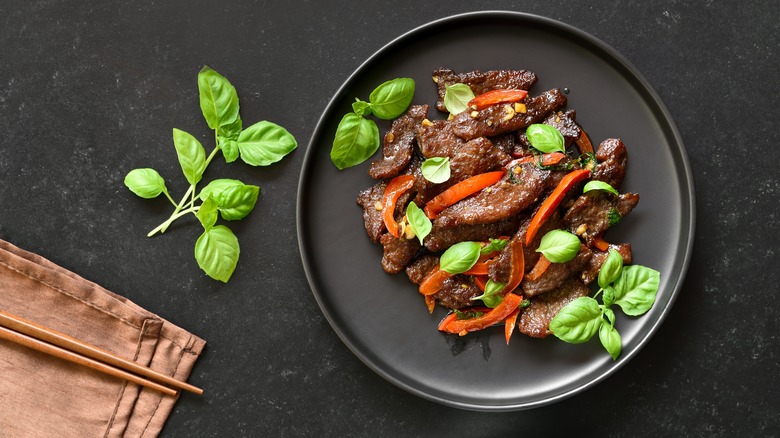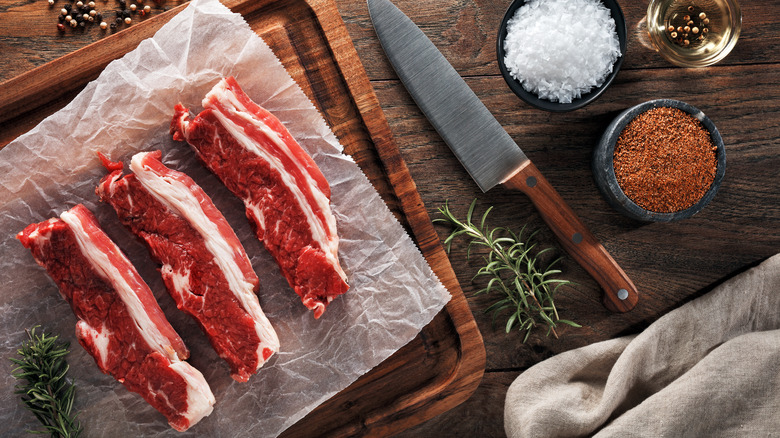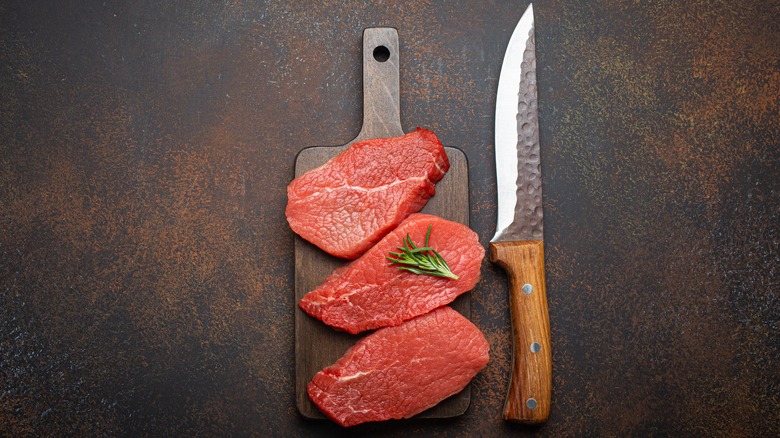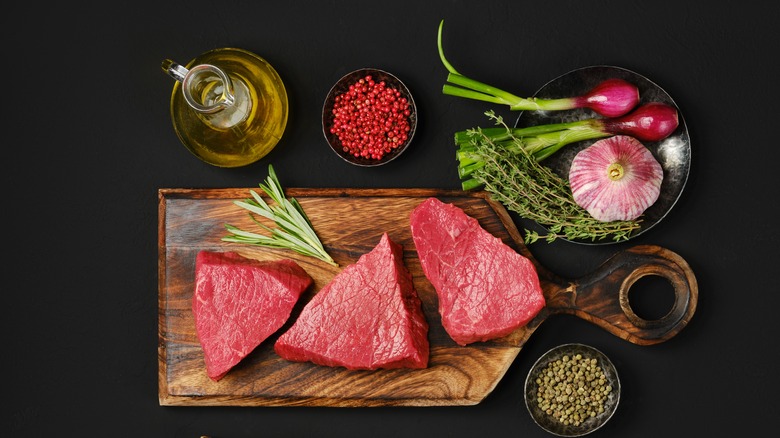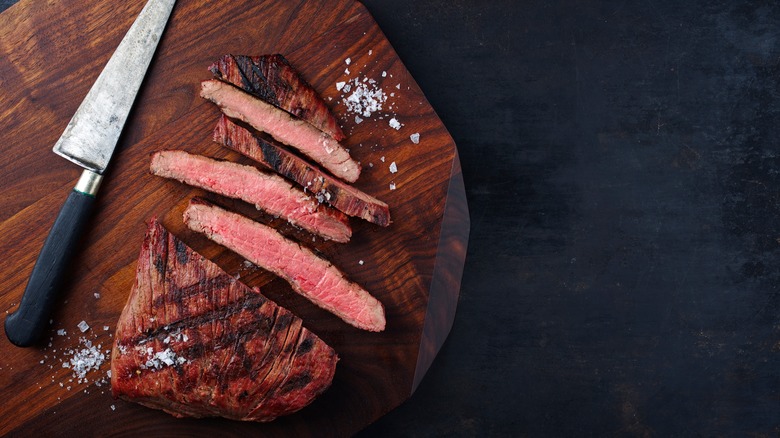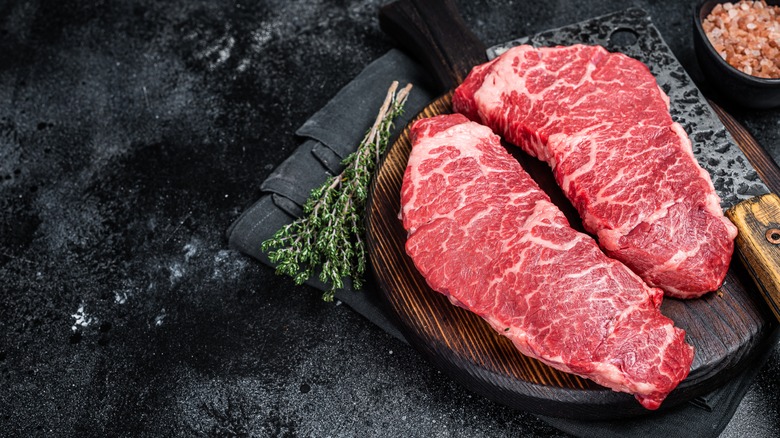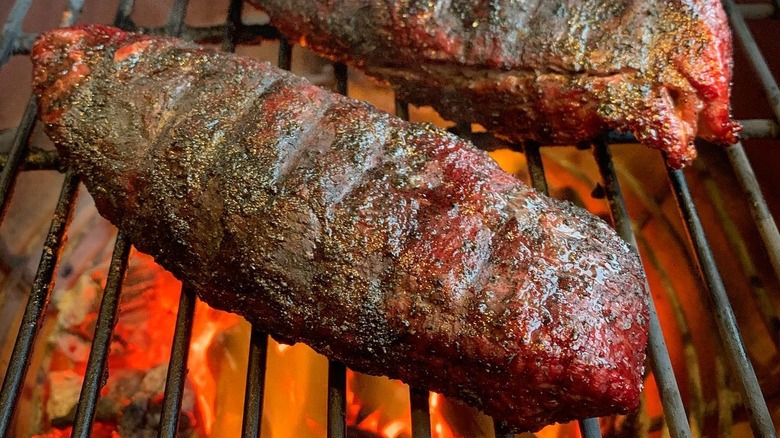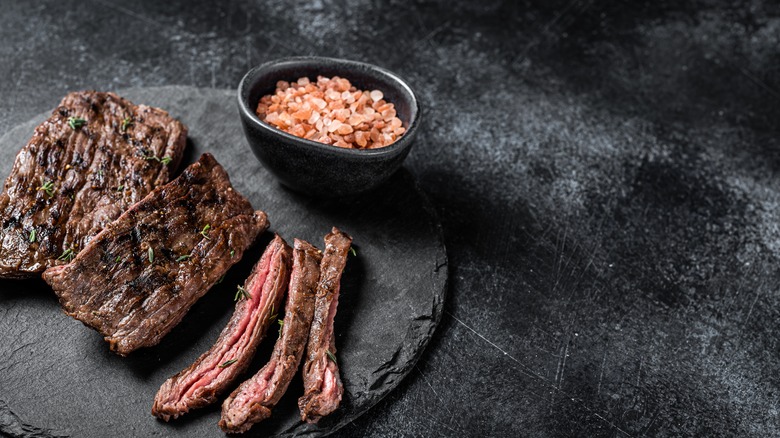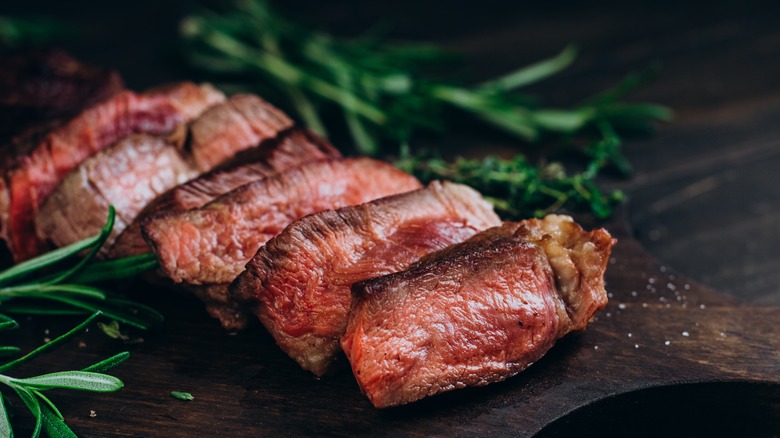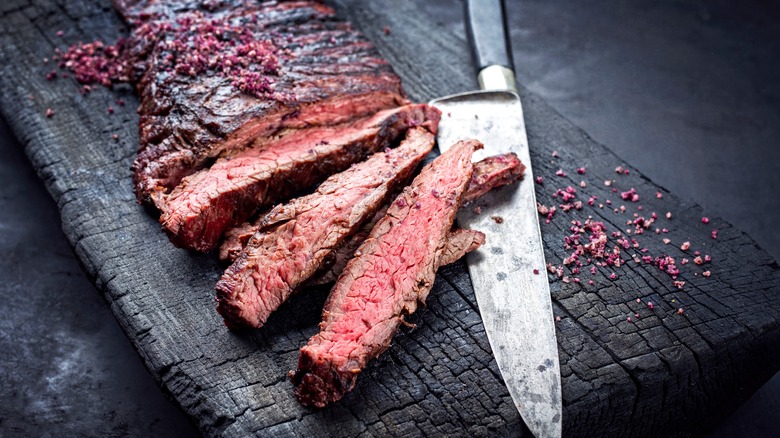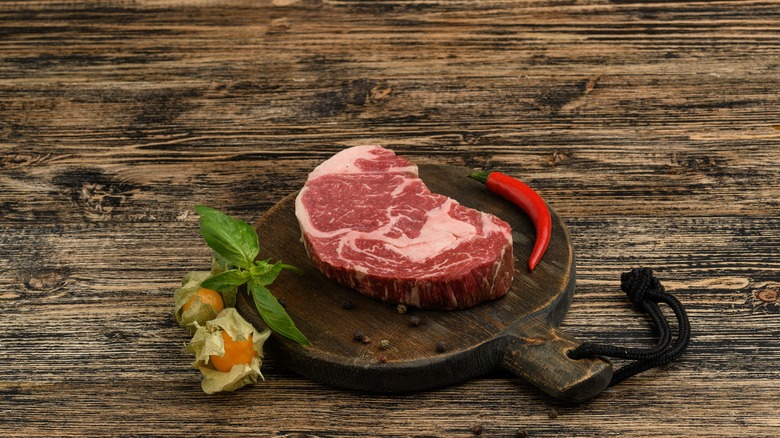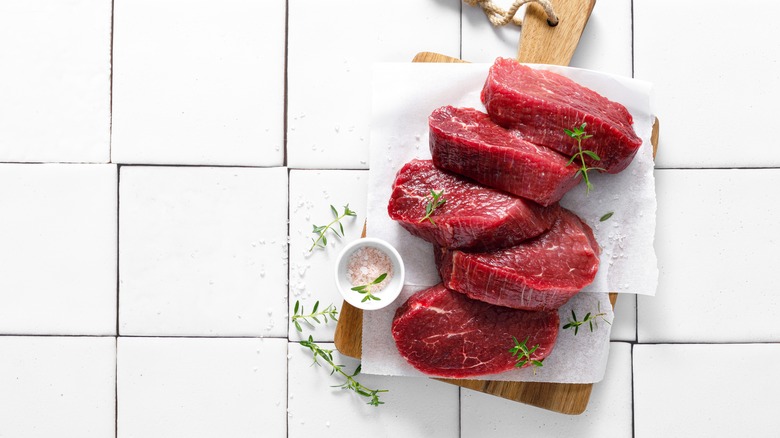11 Steak Cuts Chefs Reach For When Making Stir-Fry
There's something equally delicious and satisfying about stir=fry. Though traditionally made with Asian-inspired flavors like soy sauce, hoisin, or fish sauce, this versatile meal can be made with a nearly infinite combination of protein, vegetables, sauces, and toppings. From Mexican-influenced flavors to stir fries with Italian-esque seasoning, this dish can be iterated upon endlessly, making it a go-to for many home chefs and pros alike. And while stir-fry can be commonly found made with meats like succulent shrimp or juicy, butter-filled chicken, there's something extra appealing about a savory stir-fry made with juicy steak.
While many different cuts of beef fit the bill when making stir-fry, there are some that are better-suited than others. We spoke with a few experts to get their opinion on which steak cuts will help level-up your next stir-fry dinner. Read on to discover which steak David Rose (Omaha Steaks Executive Chef) and Ted Rosen (Dickson's Farmstand Meats Executive Chef) recommend for your next stir-fry.
1. Boneless short ribs
Though the name may make it sound like short ribs come from the cow's ribs, they're actually a flavorful and tender cut of beef that comes from the shoulder. This area of the cow is filled with fat to give the meat delicious flavor, making short ribs an ideal option for low and slow cooking — which is why you'll often see them in delicious recipes that call for braising.
"Boneless short ribs can be a really nice and indulgent option — think Kalbi (Korean-style short ribs) but remove the bones and cut into strips," said Ted Rosen. Short ribs are a versatile option for stir-fry because they can be cooked in many different ways, from grilling to braising to roasting. Just be sure to not overcook this cut as it can lead to a tough end result; aim for rare or medium-rare for optimal flavor and texture. When making stir-fry, consider cooking the short ribs and vegetables separately to ensure they are both perfectly done before combining the two.
2. Top sirloin
Though many people treat top sirloin like the main event in their meal, it can also be easily combined with your favorite vegetables, sauce, and other components to make a delicious stir-fry. "Top sirloin can be a budget-friendly option with a more succulent flavor," David Rose explained.
Known for its bold flavor, this cut of steak is lean and tender. Sourced from the loin primal cut near the cow's hind legs, the top sirloin is an area filled with a lot of muscle (versus fat) which results in less marbling and a firmer texture than other steak cuts. Before using in a stir-fry, consider marinating for a few hours — or even overnight — to help infuse the steak with flavor and tenderize the meat before cooking. You can then pan sear the steak on your stovetop, grill, or even broil the meat for versatile cooking options. Just avoid cooking it past medium-rare, as it can cause the steak to become tough and chewy.
3. Tri-tip
The tri-tip can be found just below the top sirloin on the cow's hindquarters. This delicious steak gets its name from the distinctive shape: a triangle-shaped cut that is tapered on one end.
This beautifully marbled steak is surprisingly affordable given its flavor and texture, and it's often a less expensive alternative to popular steaks like ribeye or strip. "You shouldn't be breaking the bank to make a stir-fry regardless of which cut of steak you choose. Any middle-priced cut should work," said Ted Rosen.
Tri-tip is best prepared whole, so try roasting or grilling the steak whole before slicing and adding to your stir-fried veggies and sauce. This also makes it easier to achieve a medium-rare cook, the preferred doneness for this cut. Just pay attention when carving the steak — this cut has two different grain patterns that can be tricky to navigate the first few times. Experts recommend slicing the steak in half and then cutting each half against the grain for the most tender results.
4. Flank steak
Flank steak comes from the cow's underbelly, or its flank. This lean, muscled area has little fat but offers unmatched intensity of flavor. Because of its tougher nature, flank steak lends itself well to marinating, which makes it the ideal option for stir-fry. Acidic marinade ingredients like vinegar, citrus juice, or other fruits like pineapple and mango can help break down the meat's connective tissue and make it more tender.
Once your steak is marinated, slice it thinly across the grain before adding to your stir-fry. "You should always cut against the grain to make the meat more tender and easier to chew. This is especially important for a lean cut with long muscle fibers like the flank steak," said David Rose. Once sliced, cook quickly at a high heat with your favorite stir-fry ingredients to avoid added toughness. Aim for a rarer finish on flank steak (the rarer, the better) for the best taste and texture.
5. Denver steak
When making stir-fry, David Rose recommends "look for a lean steak with a good amount of marbling," and Denver steak fits the bill. Sourced from the chuck primal cut at the cow's shoulder, Denver steak is a heavily marbled, rich steak. Unlike other steaks from this primal cut, the Denver steak can be found under the shoulder blade — this makes it one of the most tender cuts from this area. And though it's long been popular among butchers and chefs, Denver steak is finally gaining popularity among home cooks, too.
Though the Denver steak is tender and delicious, it's lower in calories and fat than other popular cuts like ribeye, making it a smart option for those watching their calorie intake but still craving a meal with red meat. Like most steaks, Denver steak should be cut against the grain for the most ideal texture. Because of the steak's irregular shape, however, you may end up with unevenly shaped pieces. Like flank steak, Denver steak is best cooked quickly in a high-heat skillet to keep it juicy and tender.
6. Teres major
This relatively unknown steak is a delicious and tender option filled with flavor. Almost as tender as a tenderloin, this cut is similar in taste and texture but much smaller; it typically maxes out around 10 to 12 ounces.
Though it may be similar in size and tenderness to the tenderloin, the teres major has a much more intense flavor because it is sourced from a heavily muscled area of the cow. Comparable to hanger steak, the flavor is rich and beefy. This intensity of flavor means the steak doesn't need much to taste delicious. You can keep your stir-fry recipe super simple, and the results will still taste great.
Just be sure to properly prep your teres major steak before serving. You may need to trim the silver skin — the tough connective tissue that surrounds the steak — to maximize tenderness. Skipping this step will result in a chewy, tough bite that can ruin your meal.
7. Skirt steak
Skirt steak is a popular option for many dishes that require marinades, like tacos — and the same qualities that make it well-suited for those dishes also make it the perfect cut for stir-fry. This mouth-watering cut comes from the plate of the cow, found under the ribs, and has a loose structure that absorbs flavor well.
"Flank and skirt steak are less expensive than other cuts like filet mignon or ribeye," explains David Rose. Because this fatty area has higher amounts of connective tissue, it can make the steak tough when butchered or prepared incorrectly — but it also helps make the steak a more economical option perfect for weeknight meals.
Because skirt steak is typically sold in one long piece up to 2 feet long, cutting against the grain can be tricky. To make it simpler, cut the steak into a few smaller pieces before cutting strips for your stir-fry. This ensures you can achieve bite-sized pieces while still always going against the grain for maximum tenderness.
8. Chuck steak
When most people think of chuck steak, their mind immediately goes to stews or other dishes that are cooked low and slow to tenderize this typically tough cut. But even though chuck is often overlooked, you can utilize this steak for stir-fry, too.
Sourced from the chuck primal cut, this cut is heavily muscled with little fat. It is typically cut into one- to three-inch thick slices, making it well-suited for your favorite stir-fry recipe. "You can also use round or chuck steak in stir-fry. These are generally tougher cuts that require a slower cooking time, but if sliced thinly enough, they can work well in a stir-fry," said David Rose. Another bonus is that because it's a tougher cut, chuck steak tends to be more affordable, too.
Like flank steak, chuck steak should first be marinated with tenderizing, acidic ingredients like lemon juice, vinegar, or even alcohol. These ingredients unravel the protein to make it less tough and easier to eat, delivering a delicious final dish.
9. Bavette steak
When choosing a steak cut for stir-fry, Ted Rosen looks for "steak with some marbling to add flavor and help keep things tender." Bavette steak is an often-overlooked cut that checks this box, big time. This beautifully marbled steak is tender and delicious with intense beefy flavor. Also known as flap steak, this long, thin steak has a loose texture that resembles flank or skirt steak. These similar characteristics mean that bavette is also well-suited to absorb marinades. And it's the ideal cut for recipes that require long, thin strips of steak, just like stir-fry.
Because bavette is so marbled, it does require a bit of trimming before cooking. Remove all excess fat before marinating, and then it is best prepared in a cast iron pan or similar over high heat. All it needs is about 3 to 5 minutes per side before it's ready to eat.
10. Boneless ribeye
Boneless ribeye is a triple-threat cut — it delivers on tenderness, flavor, and price. This boneless steak is well-marbled and comes from a lightly muscled area of the cow, giving it a lot of fat and a tender texture. It also absorbs flavor well and holds its shape, making it perfect for dishes like stir-fry.
Sometimes also called scotch fillet in some regions, rib-eye (like many steaks) should be cooked quickly over a high heat. Because of its highly marbled nature, however, rib-eye can be cooked to varying levels of doneness while still maintaining tenderness. Whether you prefer your steak rare or medium, it will have a rich, beefy flavor and fine grain.
To complement this richness, consider adding bright, fresh, or slightly sweet vegetables to your stir-fry like asparagus, broccoli, or carrots. Certain mushrooms, like shiitakes or portobellos, will also mimic the meaty flavor and texture of the steak, bulking up the stir-fry and making it extra satisfying. Before buying your next boneless ribeye, learn everything you need to know to pick the ideal piece.
11. Tenderloin steak
Often considered the most tender cut of beef available, tenderloin is a delicious option for stir-fry. Sourced from the loin (as the name suggests), the tenderloin is the same cut where you will find filet mignon — the filets are simply smaller, individual portions of the larger tenderloin.
Unlike many other desirable cuts, the tenderloin isn't known for its marbling. The lean cut can dry out quickly if prepared improperly, so be sure to cook it quickly over high heat to lock in the tasty juices. You'll also want to avoid cooking it past medium-rare to help maintain that moisture.
The only downside? Because of the sought-after nature of this steak, it comes with a premium price tag. Compared to more affordable cuts like top sirloin or bavette steak, the tenderloin can often come in at more than double the price per pound. While it may be expensive, the mouth-watering flavor makes it worth it for some to amp up their favorite stir-fry recipes.
